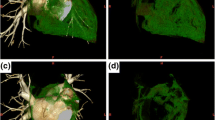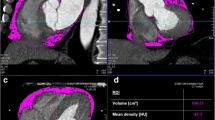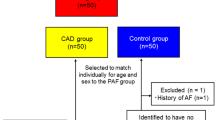Abstract
Epicardial adipose tissue (EAT) induces inflammation in the atria and is associated with atrial fibrillation (AF). Several studies have examined the relationship between EAT volume (EAT-V) and density (EAT-D) and the presence of AF after catheter ablation. However, conclusions have been inconsistent. This study included 43 consecutive patients who underwent catheter ablation for AF and 30 control patients. EAT-V and EAT-D around the entire heart, entire atrium, left atrium (LA), and right atrium (RA) were measured in detail using reconstructed three-dimensional (3D) EAT images from dual-source computed tomography (CT). None of the measurements of EAT-V differed significantly between patients with AF and controls or between patients with recurrent AF and those without. On the other hand, all measurements of EAT-D were higher in patients with AF than in controls (entire atrium, p < 0.001; RA, p < 0.001; LA, p = 0.002). All EAT-D measurements were associated with the presence of AF. Among patients with AF who underwent ablation, all EAT-D measurements were higher in patients with recurrent AF than in those without. The difference was significant for EATRA-D (p = 0.032). All atrial EAT-D values predicted recurrent AF (EATRA-D: hazard ratio [HR], 1.208; 95% confidence interval [95% CI], 1.053–1.387; p = 0.007; EATLA-D: HR, 1.108; 95% CI 1.001–1.225; p = 0.047; EATatrial-D: HR, 1.174; 95% CI 1.040–1.325; p = 0.010). The most sensitive cutoffs for predicting recurrent AF were highly accurate for EATRA-D (area under the curve [AUC], 0.76; p < 0.01) and EATatrial-D (AUC = 0.75, p < 0.05), while the cutoff for EATLA-D had low accuracy (AUC, 0.65; p = 0.209). For predicting the presence of AF and recurrent AF after catheter ablation, 3D analysis of atrial EAT-D, rather than EAT-V, is useful.


Similar content being viewed by others
Data availability
Data and materials are available from the corresponding author upon reasonable request.
References
Mazurek T, Zhang L, Zalewski A, Mannion JD, Diehl JT, Arafat H, Sarov-Blat L, O’Brien S, Keiper EA, Johnson AG, Martin J, Goldstein BJ, Shi Y (2003) Human epicardial adipose tissue is a source of inflammatory mediators. Circulation 108:2460–2466
Ouwens DM, Sell H, Greulich S, Eckel J (2010) The role of epicardial and perivascular adipose tissue in the pathophysiology of cardiovascular disease. J Cell Mol Med 14:2223–2234
Conte M, Petraglia L, Cabaro S, Valerio V, Poggio P, Pilato E, Attena E, Russo V, Ferro A, Formisano P, Leosco D, Parisi V (2022) Epicardial adipose tissue and cardiac arrhythmias: focus on atrial fibrillation. Front Cardiovasc Med 9:932262
Takahashi N, Abe I, Kira S, Ishii Y (2023) Role of epicardial adipose tissue in human atrial fibrillation. J Arrhythm 39:93–110
Al Chekakie MO, Welles CC, Metoyer R, Metoyer R, Ibrahim A, Shapira AR, Cytron J, Santucci P, Wilber D, Akar JG (2010) Pericardial fat is independently associated with human atrial fibrillation. J Am Coll Cardiol 56:784–788
Nagashima K, Okumura Y, Watanabe I, Nakai T, Ohkubo K, Kofune T, Kofune M, Mano H, Sonoda K, Hirayama A (2011) Association between epicardial adipose tissue volumes on 3-dimensional reconstructed CT images and recurrence of atrial fibrillation after catheter ablation. Circ J 75:2559–2565
Masuda M, Mizuno H, Enchi Y, Minamiguchi H, Konishi S, Ohtani T, Yamaguchi O, Okuyama Y, Nanto S, Sakata Y (2015) Abundant epicardial adipose tissue surrounding the left atrium predicts early rather than late recurrence of atrial fibrillation after catheter ablation. J Interv Card Electrophysiol 44:31–37
Nakamori S, Nezafat M, Ngo LH, Manning WJ, Nezafat R (2018) Left Atrial Epicardial Fat Volume Is Associated With Atrial Fibrillation: a prospective cardiovascular magnetic resonance 3D dixon study. J Am Heart Assoc 7:e008232
Kusayama T, Furusho H, Kashiwagi H, Kato T, Murai H, Usui S, Kaneko S, Takamura M (2016) Inflammation of left atrial epicardial adipose tissue is associated with paroxysmal atrial fibrillation. J Cardiol 68:406–411
Ciuffo L, Nguyen H, Marques MD, Aronis KN, Sivasambu B, de Vasconcelos HD, Tao S, Spragg DD, Marine JE, Berger RD, Lima ACJ, Calkins H, Ashikaga H (2019) Periatrial fat quality predicts atrial fibrillation ablation outcome. Circ Cardiovasc Imaging 12:e008764
El Mahdiui M, Simon J, Smit JM, Kuneman JH, van Rosendael AR, Steyerberg EW, van der Geest RJ, Száraz L, Herczeg S, Szegedi N, Gellér L, Delgado V, Merkely B, Bax JJ, Maurovich-Horvat P (2021) Posterior left atrial adipose tissue attenuation assessed by computed tomography and recurrence of atrial fibrillation after catheter ablation. Circ Arrhythm Electrophysiol 14:e009135
Yang M, Bao W, Xu Z, Qin L, Zhang N, Yan F, Yang W (2022) Association between epicardial adipose tissue and recurrence of atrial fibrillation after ablation: a propensity score-matched analysis. Int J Cardiovasc Imaging 38:1865–1872
Stiles MK, John B, Wong CX, Kuklik P, Brooks AG, Lau DH, Dimitri H, Roberts-Thomson KC, Wilson L, Sciccio PD, Young GD, Sanders P (2009) Paroxysmal lone atrial fibrillation is associated with an abnormal atrial substrate: characterizing the “second factor.” J Am Coll Cardiol 53:1182–1191
Platonov PG, Mitrofanova LB, Orshanskaya V, Ho SY (2011) Structural abnormalities in atrial walls are associated with presence and persistency of atrial fibrillation but not with age. J Am Coll Cardiol 58:2225–2232
Iacobellis G (2015) Local and systemic effects of the multifaceted epicardial adipose tissue depot. Nat Rev Endocrinol 11:363–371
Aldiss P, Davies G, Woods R, Budge H, Sacks HS, Symonds ME (2017) ‘Browning’ the cardiac and peri-vascular adipose tissues to modulate cardiovascular risk. Int J Cardiol 228:265–274
Tselentakis EV, Woodford E, Chandy J, Gaudette GR, Saltman AE (2006) Inflammation effects on the electrical properties of atrial tissue and inducibility of postoperative atrial fibrillation. J Surg Res 135:68–75
Zhang M, Kono M (1997) Solitary pulmonary nodules: evaluation of blood flow patterns with dynamic CT. Radiology 205:471–478
Antonopoulos AS, Sanna F, Sabharwal N, Thomas S, Oikonomou EK, Herdman L, Margaritis M, Shirodaria C, Kampoli AM, Akoumianakis I, Petrou M, Sayeed R, Krasopoulos G, Psarros C, Ciccone P, Brophy CM, Digby J, Kelion A, Uberoi R, Anthony S, Alexopoulos N, Tousoulis D, Achenbach S, Neubauer S, Channon KM, Antoniades C (2017) Detecting human coronary inflammation by imaging perivascular fat. Sci Transl Med. 9:eaal2658
Mahabadi AA, Lehmann N, Kalsch H, Bauer M, Dykun I, Kara K, Moebus S, Jockel KH, Erbel R, Mohlenkamp S (2014) Association of epicardial adipose tissue and left atrial size on non-contrast CT with atrial fibrillation: the Heinz Nixdorf recall study. Eur Heart J Cardiovasc Imaging 15:863–869
Gaibazzi N, Martini C, Benatti G, Palumbo AA, Cacciola G, Tuttolomondo D (2021) Atrial fibrillation and peri-atrial inflammation measured through adipose tissue attenuation on cardiac computed tomography. Diagnostics 11:2087
Vroomen M, Olsthoorn JR, Maesen B, L’Espoir V, La Meir M, Das M, Maessen JG, Crijns HJGM, Verheule S, Pison L (2019) Quantification of epicardial adipose tissue in patients undergoing hybrid ablation for atrial fibrillation. Eur J Cardiothorac Surg 56:79–86
Hammache N, Pegorer-Sfes H, Benali K, Magnin Poull I, Olivier A, Echivard M, Pace N, Minois D, Sadoul N, Mandry D, Sellal JM, de Chillou C (2021) Is there an association between epicardial adipose tissue and outcomes after paroxysmal atrial fibrillation catheter ablation? J Clin Med 10:3037
Hasebe H, Yoshida K, Iida M, Hatano N, Muramatsu T, Nogami A, Aonuma K (2018) Differences in the structural characteristics and distribution of epicardial adipose tissue between left and right atrial fibrillation. Europace 20:435–442
Tanisawa H, Akutsu Y, Ito H, Nomura K, Sekimoto T, Kaneko K, Kodama Y, Arai K, Gokan T, Onishi Y, Ochi A (2020) Epicardial adipose tissue in the right atrium is associated with progression of atrial fibrillation and recurrence after pulmonary vein catheter ablation in patients with atrial fibrillation. Showa Univ J Med Sci 32:11–24
Liu Z, Wang S, Wang Y, Zhou N, Shu J, Stamm C, Jiang M, Luo F (2019) Association of epicardial adipose tissue attenuation with coronary atherosclerosis in patients with a high risk of coronary artery disease. Atherosclerosis 284:230–236
Kim TH, Park J, Park JK, Uhm JS, Joung B, Lee MH, Pak HN (2014) Pericardial fat volume is associated with clinical recurrence after catheter ablation for persistent atrial fibrillation, but not paroxysmal atrial fibrillation: an analysis of over 600 patients. Int J Cardiol 176:841–846
Oba K, Maeda M, Maimaituxun G, Yamaguchi S, Arasaki O, Fukuda D, Yagi S, Hirata Y, Nishio S, Iwase T, Takao S, Kusunose K, Harada M, Masuzaki H, Sata M, Shimabukuro M (2018) Effect of the epicardial adipose tissue volume on the prevalence of paroxysmal and persistent atrial fibrillation. Circ J 82:1778–1787
Konishi M, Sugiyama S, Sugamura K, Nozaki T, Ohba K, Matsubara J, Matsuzawa Y, Sumida H, Nagayoshi Y, Nakaura T, Awai K, Yamashita Y, Jinnouchi H, Matsui K, Kimura K, Umehara S, Ogawa H (2010) Association of pericardial fat accumulation rather than abdominal obesity with coronary atherosclerotic plaque formation in patients with suspected coronary artery disease. Atherosclerosis 209:573–578
Hasebe H, Yoshida K, Nogami A, Ieda M (2020) Difference in epicardial adipose tissue distribution between paroxysmal atrial fibrillation and coronary artery disease. Heart Vessels 35:1070–1078
Acknowledgements
None.
Author information
Authors and Affiliations
Corresponding author
Ethics declarations
Conflict of interest
Hiroshi Tada received honoraria (lecture fees, presentations, or speakers bureaus) from Daiichi- Sankyo Co., Ltd., Biotronik Japan, Inc., Bristol-Myers Squibb, Nippon Boehringer Ingelheim Co., Ltd., Medtronic Japan Co., Ltd., and Novartis Pharma, K.K. Dr. Tada also received research grants from Abbott Medical Japan, LLC, Nippon Boehringer Ingelheim Co., Ltd., Daiichi-Sankyo Co., Ltd., and ALVAUS Inc. (All grants are for research that is unrelated to the subject of the manuscript.) Daisetsu Aoyama belong to endowed department by Biotronik Japan, Inc., DVx Inc., and ALVAUS Co., Ltd. Shota Kakehashi and Moe Mukai belong to endowed department by Medtronic Japan Co., Ltd., DVx Inc., Abbott Medical Japan, LLC, Boston Scientific Japan K.K., and Japan Lifeline Co., Ltd. No other authors have any conflicts of interest to disclose.
Additional information
Publisher's Note
Springer Nature remains neutral with regard to jurisdictional claims in published maps and institutional affiliations.
Rights and permissions
Springer Nature or its licensor (e.g. a society or other partner) holds exclusive rights to this article under a publishing agreement with the author(s) or other rightsholder(s); author self-archiving of the accepted manuscript version of this article is solely governed by the terms of such publishing agreement and applicable law.
About this article
Cite this article
Nodera, M., Ishida, T., Hasegawa, K. et al. Epicardial adipose tissue density predicts the presence of atrial fibrillation and its recurrence after catheter ablation: three-dimensional reconstructed image analysis. Heart Vessels (2024). https://doi.org/10.1007/s00380-024-02384-8
Received:
Accepted:
Published:
DOI: https://doi.org/10.1007/s00380-024-02384-8




